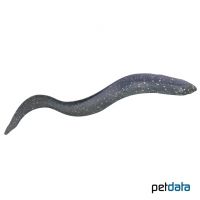South American Lungfish (Lepidosiren paradoxa)
| South American Lungfish Lepidosiren paradoxa | |
|---|---|
| Name | South American Lungfish |
| Name Lat. | Lepidosiren paradoxa |
| Family | South Amercian Lungfishes |
| Family lat. | Lepidosirenidae |
| Order | Lungfishes |
| Order lat. | Ceratodontiformes |
| Origin | Brazil, Paraguay |
| Habitat | Floodplains |
| Diet | Omnivore |
| pH | 6.5-7.5 |
| Behavior | Predatory |
| Keeping | Individual |
| Care Level | Experts only |
| Reproduction | Substrate spawner |
| Breeding | None reported |
| Life Span | 8-10 years |
| Protection | No |
| Metric Units | |
| Size | 125 cm |
| Temperature | 24-28 °C |
| Hardness | 2-20 °dH |
| Aquarium | ~ 3,000 l |
| US Units | |
| Size | 49" |
| Temperature | 75-82 °F |
| Hardness | 36-356 ppm |
| Aquarium | ~ 800 gal |
Distribution and habitat
The South American lungfish are widespread in northern and central South America. There they live in the swamps and floodplains of the Amazon basin and in the catchment area of the Rio Praguay and the lower Rio Paranà.
Maintenance
The aquarium should have dense perimeter planting with roots and large smooth rocks that provide hiding places. A deep, soft, burrowable substrate covered with some foliage and shaded light (floating plant cover) is ideal
No ammonia, ammonium and nitrite should be detectable in the water, and the nitrate value should not exceed 100 mg/l. To ensure the water quality and oxygen content should not be missing a filter adapted to the water volume.
Diet
They are predatory omnivores that feed on fish, insects, mollusks, amphibians and plant material in the wild. The diet consists of live, frozen and dry foods. For a balanced diet, feed once a day with a high quality sinking dry food (granules, pellets) as well as artemia, mysis, mosquito larvae, snails, fish and shellfish, etc. (live or frozen). In addition, they need plant food, such as algae leaves and commercially available green food (e.g. spirulina).
Only feed as much as will be eaten within a few minutes. A regular and varied diet promotes health and prevents deficiency symptoms.
Behaviour and compatibility
They are predatory, very territorial and biting fish. Single keeping is recommended, several animals should only be kept together in a much larger and richly structured tank. They can only be socialized with fish of the same size or larger that do not fit their prey pattern.
Basically, only compatible fish species with similar demands on water condition and water temperature may be socialized.
Sex dimorphism
There are no known external distinguishing characteristics.
Reproduction and breeding
There are no known reports of successful breeding in the aquarium. In the wild they dig deep burrows in the substrate where eggs are laid. The male guards spawn and larvae. The juveniles have external gills, which later regress.
Important
They have gills and lungs that allow them to live in the low acid water and breathe atmospheric air from the surface. During the dry season, they burrow deep into the ground and lie curled up in a small amount of residual water.
Extreme care should be taken when handling them in the aquarium as they can cause painful bite injuries.
The well-being of the fish should be checked regularly. Temperature should be checked daily, pH, hardness and nitrate levels at least every 14 days. Regular partial water changes are recommended, even when contaminant levels have not yet reached the upper limit. Sudden changes in water quality should be avoided. Newly introduced fish must be accustomed slowly to the water in the aquarium.
Further literature can be found in your pet store.
References
Text: Werner Winter; Image: petdata
Source: BMELV (1998): Tierschutzgutachten - Haltung von Zierfischen (Süßwasser); BAENSCH & RIEHL (2006): Aquarien Atlas Bd. 2, Mergus Verlag; ENGELMANN (2005): Zootierhaltung - Tiere in menschlicher Obhut: Fische; Harri Deutsch Verlag
- Gemäß § 21 Abs. 5 Tierschutzgesetz idgF
